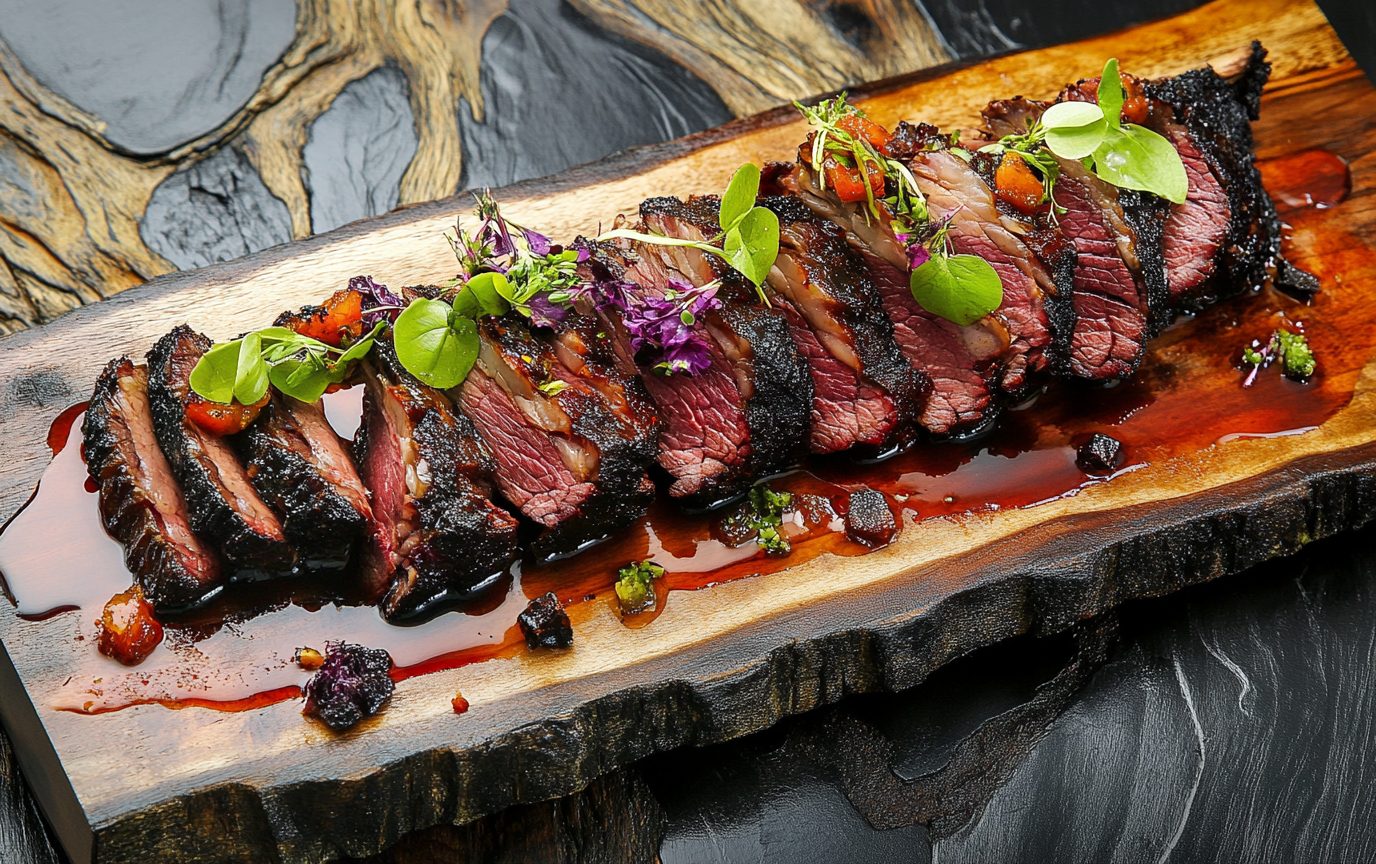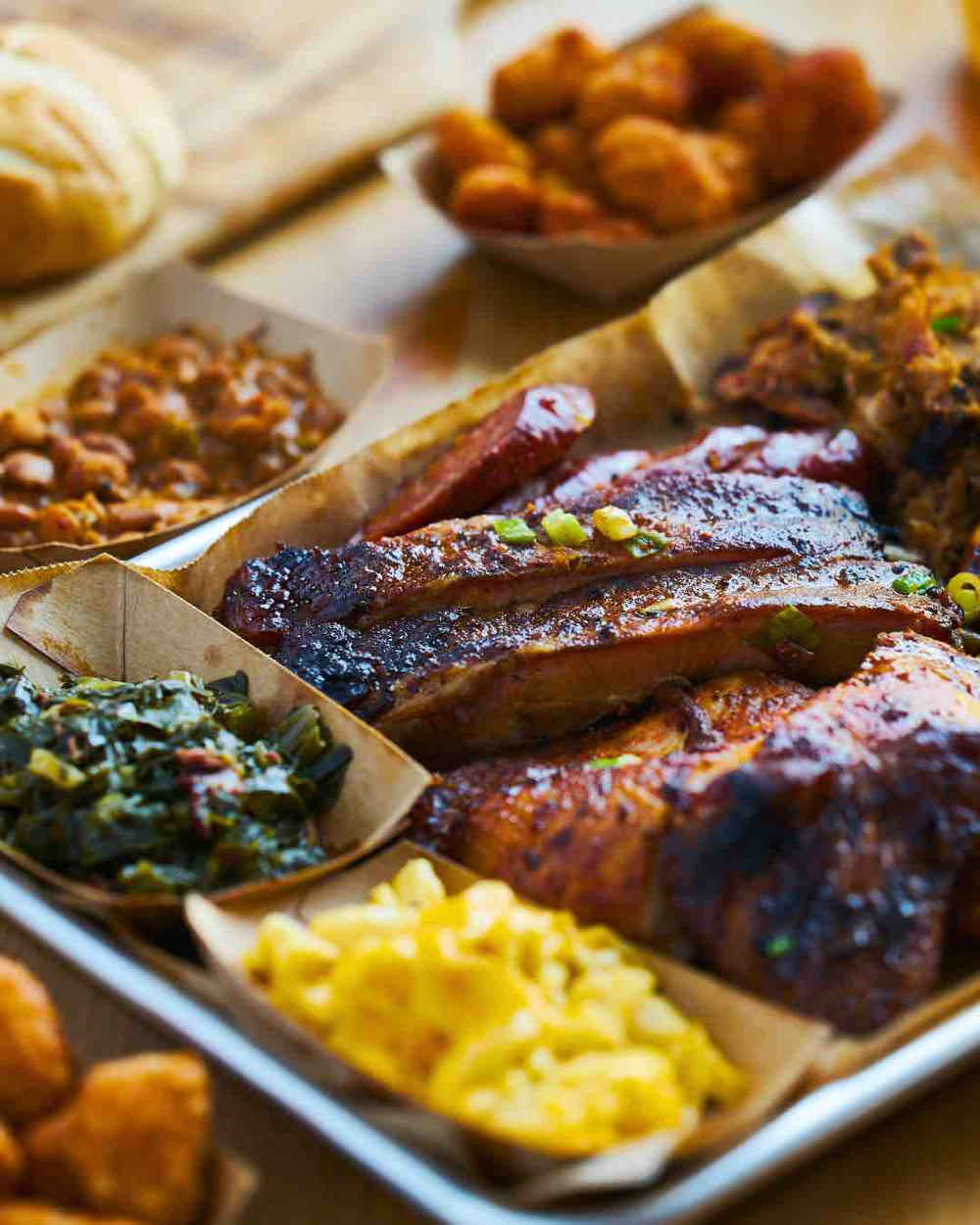The Science Behind Brisket Flavor
Understanding the Composition of Brisket
Brisket is a unique cut of meat derived from the breast or lower chest of beef cattle. Its composition is fundamental to the flavor and texture that make brisket a beloved staple in barbecue culture. The main components that contribute to brisket’s character are collagen, fat, and muscle fibers.
- Collagen: This connective tissue is abundant in brisket. When cooked slowly at low temperatures, collagen transforms into gelatin, adding a rich, succulent mouthfeel to the meat.
- Fat: The fat cap on brisket serves several purposes. Apart from contributing flavor, it insulates the meat, retaining moisture during cooking. The marbling, or intramuscular fat, can significantly enhance the brisket’s richness.
- Muscle Fibers: The structure of the muscle fibers influences the tenderness and chewiness. Brisket has both the flat (leaner) and the point (fattier) cuts, each offering distinct textures and flavors.
These elements work in harmony to create the complex flavor profile brisket aficionados crave. Understanding this can greatly enhance one’s approach to cooking.
Factors Influencing the Flavor Profile
Several key factors affect the flavor profile of brisket, some of which include:
- Selection of Meat: Choosing high-quality brisket, ideally USDA Choice or better, can make a world of difference. Cuts with more marbling tend to be more flavorful and juicy.
- Cooking Method: The technique of “low and slow” cooking is essential for brisket. This method not only breaks down collagen but also allows for the Maillard reaction, which is responsible for that appetizing crust and complex flavors.
- Wood Selection: The type of wood used for smoking imparts additional flavor. Mesquite provides a strong taste while fruitwoods like apple or cherry add sweetness.
- Seasoning: A well-applied rub enhances the surface of the brisket, creating a flavorful crust. The traditional Texas rubs typically consist of salt and pepper, but pitmasters often experiment with additional spices.
- Resting Period: Allowing the brisket to rest after cooking is vital. This step helps redistribute the juices, ensuring a moist and tender final product.
By considering these factors, even a novice cook can elevate their brisket game, crafting a smoky, flavorful masterpiece worthy of any barbecue gathering. Understanding the science behind these elements can turn cooking brisket from a simple task into a rewarding culinary experience.

Traditional vs. Modern Approaches to Brisket
Historical Significance of Brisket Flavor
Brisket has long been a cherished cut in barbecue culture, steeped in history and tradition. Originating from tough but flavorful cuts of meat, brisket epitomizes the art of slow cooking. Its historical significance is evident in various regional barbecue traditions across the United States.
- In Texas, brisket is more than just a dish; it’s a cultural symbol. Slow-smoked over post-oak wood with a simple salt and pepper rub, it showcases the commitment to craftsmanship in barbecue. The process transcends mere cooking—it’s ritualistic, representing a labor of love that creates an iconic Texas staple.
- In Kansas City, brisket takes on a different flair. Here, the meat is often slathered in a thick, sweet sauce, marrying diverse flavors that reflect the melting pot nature of this barbecue capital. This approach showcases brisket’s versatility, allowing it to adapt and thrive in various culinary contexts.
Across Southern kitchens, brisket is often celebrated in different forms, whether slow-smoked, braised, or oven-roasted. Each preparation reflects local preferences and culinary histories, solidifying brisket’s role as a centerpiece in American barbecue culture.
Contemporary Techniques for Enhancing Flavor
Modern barbecue techniques are evolving and embracing innovation while respecting traditional roots. Today’s pitmasters are combining age-old methods with new culinary ideas, revamping how we experience brisket.
- Brining and Marinades:
- Many contemporary cooks opt to brine brisket before cooking. This process involves soaking the meat in a solution of salt and seasoning for several hours, enhancing flavor and moisture retention. For instance, a popular brine might include ingredients like apple cider vinegar and a mix of spices to introduce a tangy kick.
- Experimenting with Rubs:
- While traditional salt and pepper rubs remain popular, many cooks now experiment with custom blends that may feature ingredients like smoked paprika, garlic powder, and even brown sugar. These unique rubs can create layers of flavor that elevate the meat’s natural profile.
- Smoking Techniques:
- Modern pitmasters are also getting creative with wood choices. While classic hickory or oak is still in use, woods like cherry or mesquite have gained popularity, adding new depths of flavor. The timing of wood application is crucial as well, with many preferring to start with a stronger flavor and transitioning to milder woods during the cooking process.
- Sous Vide Methods:
- Some chefs are integrating sous vide techniques to ensure perfect doneness and tenderness. This method involves cooking the brisket in a vacuum-sealed bag at a precise temperature over an extended period, allowing for maximum control over the final product.
- Flavor Enhancements During Cooking:
- Adding spritzes of apple cider or a mix of water and vinegar during smoking can help maintain moisture and add subtle flavor enhancements.
By blending these contemporary techniques with traditional practices, modern pitmasters are redefining brisket, creating a fusion of culinary history and innovation that delights the senses and keeps the beloved tradition alive. Whether you prefer the classic approach or the modern twists, brisket continues to evolve, promising a rich tapestry of flavors and techniques worthy of any barbecue enthusiast’s table.
Regional Variations in Brisket Preparation
Texan BBQ: A Deep Dive into Brisket Flavor
When it comes to brisket, Texas is the undisputed heavyweight champion, serving as a benchmark for barbecue lovers everywhere. Texan BBQ deeply respects the primal cut, honoring three crucial factors: the quality of the meat, the cooking method, and the seasoning approach.
- Quality of Meat: In Texas, the best brisket starts with a high-quality cut, typically USDA Choice or Prime. Many pitmasters recommend using Angus brisket as it offers superior marbling, ensuring tenderness and flavor.
- Cooking Method: The hallmark style is smoking the brisket “low and slow,” often between 225°F and 250°F. This extended cooking time allows the collagen to break down gradually, yielding tender, juicy slices. Using post-oak wood for smoking imparts a subtle flavor that complements the meat without overwhelming it.
- Simple Seasoning: A true Texan brisket often keeps it simple with just a rub of salt and black pepper, sometimes referred to as a “Dalmatian rub.” This minimalist approach highlights the meat’s natural flavors and lets the smoke shine through.
The result? A brisket with a characteristically thick, dark bark that’s slightly chewy yet not hard. Each bite reveals a tender, juicy interior with a slight resistance, showcasing the skill of the pitmaster.
Eastern European Influences on Brisket Taste
Brisket preparations have also found their way into Eastern European cuisine, particularly within Jewish culinary traditions. Here, the emphasis shifts from smoking to braising, where the brisket showcases an entirely different flavor profile.
- Braising Techniques: Traditionally, Jewish families prepare brisket as a pot roast. The brisket is often slow-cooked in a mixture of beef broth, onions, and a variety of spices. This method infuses the meat with rich flavors, as it soaks up the savory broth over several hours on low heat.
- Flavor Enhancements: Eastern European spices, such as garlic, paprika, and sometimes a hint of sweetness from sugar or caramelized onions, transform the brisket into a decadent dish.
Families often serve this succulent brisket alongside traditional sides such as potato kugel or challah, creating a comforting meal steeped in culinary history.
The result is a dish that’s not just about feeding the hungry but also about celebrating heritage and familial bonds.
In this way, brisket serves as a versatile canvas, absorbing regional influences and adapting to local tastes, whether it’s the smoky, robust flavors of Texan BBQ or the rich, comforting textures found in Eastern European homes. Each style is a testament to the cultural significance of this beloved cut, showcasing how cooking methods can evoke nostalgia and community.

Flavor Pairings and Complementary Sides
Ideal Seasonings for Highlighting Brisket Flavor
When it comes to brisket, the seasoning is crucial in framing its robust flavors. The aim is to enhance rather than overshadow the natural taste of the beef. Here are some ideal seasonings that make brisket shine:
- Salt and Black Pepper: The quintessential brisket rub often revolves around these two staples. Kosher salt and coarse black pepper form the backbone of a simple yet effective seasoning base, allowing the meat’s flavor to take center stage.
- Brown Sugar: Adding a bit of brown sugar brings a sweet contrast that beautifully balances the meat’s savory profile. Plus, it contributes to an amazing caramelized crust during cooking.
- Garlic and Onion Powder: These aromatics elevate the flavor profile with their savory depth. A blend of both not only adds layers of taste but also contributes to the coveted bark that everyone craves.
- Cayenne Pepper: For those who enjoy a little heat, a sprinkle of cayenne can kick things up a notch. Just be sure to moderate the amount, as the goal is to enhance the experience without overwhelming it.
Experimenting with seasonings based on personal preferences is a part of the fun in preparing brisket. Many pitmasters find joy in developing their signature rubs! For example, some may even toss in ingredients like smoked paprika or Worcestershire sauce for a unique twist.
Side Dishes that Elevate the Taste of Brisket
A perfectly smoked brisket deserves equally enticing side dishes. The right accompaniments can enhance the overall experience, bringing balance to the richness of the meat. Here are some side dishes that pair wonderfully with brisket:
- Creamy Coleslaw: Its crunchy texture and tangy flavor provide a delightful contrast to tender brisket. The acidity counteracts the richness, cleansing the palate perfectly between bites.
- Buttery Cornbread: This Southern classic, with its slightly sweet and dense texture, is an absolute must. It acts as a sponge to soak up all those delightful brisket juices, making every bite a little piece of heaven.
- Tangy Baked Beans: The smoky sweetness of baked beans complements the depth of brisket flavors. Their hearty consistency adds comfort and satisfaction to any plate.
- Garlic Mashed Potatoes: Smooth and indulgent, these potatoes allow the brisket’s unique flavors to shine without competing. The roasted garlic offers a fragrant kick that enhances the entire meal.
- Roasted Vegetables: Grilled or roasted seasonal veggies, such as zucchini and bell peppers, add a bright freshness that balances the richness of the brisket perfectly.
- Pickles and Onions: A simple serving of sliced pickles and onions provides the crunch and acidity needed to cut through the heaviness of the meat, making for an appealing contrast.
These side dishes not only elevate the brisket but also create an inviting feast that celebrates the joy of good food shared amongst family and friends. So, as you prep that smoky chunk of goodness, don’t forget to whip up these delightful accompaniments for a truly unforgettable meal

Leave a Reply